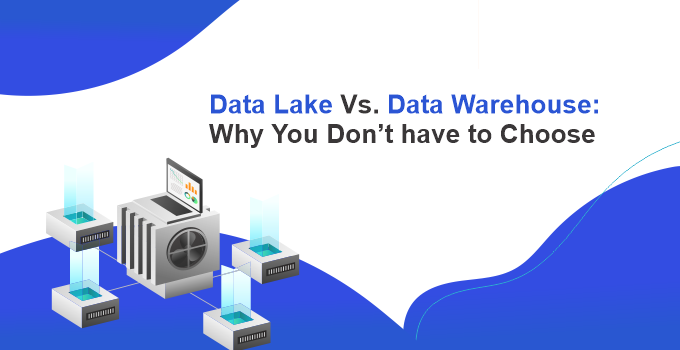Data Lake Vs. Data Warehouse: Why You Don’t Have To Choose
If you’ve been paying attention to any recent data and analytics technologies, you’ll have seen the terms Data Lake and Data Warehouse popping up quite a bit. The goal of this post is to explain why, despite the overlap in terms and focus, these two data technologies aren’t competing with one another. The fact is that they can work together to improve your business intelligence strategy but to do so you also need to understand what each technology does well by itself.
What Is Meant By Data Lake?
The data lake is a new way of storing data that is more flexible and scalable than traditional databases. It can handle unstructured data and is designed to enable the easy sharing and analysis of large quantities of data, such as video and images and social media. Data Lake stores all the data collected through different sources like web crawlers, emails, communication platforms like Slack, social media platforms like Twitter and LinkedIn, etc.
Data Lake can be accessed by many means like desktop applications, microservices, APIs and stored in the cloud or local servers. Data can be stored in JSON (JavaScript Object Notation) or any other format in the Data Lake. In Data Lake, there are two sorts of fields:
- Administrative
– It includes all the general information required to maintain records of data collected by any source.
- Operational
– It contains all the data collected from each source to fulfill the purpose of storing it in Data Lake.
Click here to read: How to Make Big Data Implementation a Success: Roadmap and Best Practices to Follow
Data Warehouse
The most important thing about a Data Warehouse is that it stores vast amounts of unstructured data related to your business. One of the most essential technologies used by businesses to extract value from data is the data warehouse. A data warehouse stores and organizes information so that it can be analyzed and used more easily.
Data warehouses are not new technology, but they are getting more popular as an efficient way for companies to use internal data to improve their products, processes, and services. They are more useful than ever in the age of Big Data. Some of the key differences between data lack and data warehouse are listed below.
1.Data Type
One of the most important data skills is cleaning data because data in the real world usually come in messy and imperfect forms. The digital assets we all create and collect every day — social media posts, photos, videos, e-mails, work documents, etc. are mostly unstructured data. Structured data, on the other hand, is organized into columns and rows—the stuff that computers understand.
Data lakes are specialized databases for storing large amounts of raw data. For example, data lakes can be used to collect IoT data, social media data, user data, and web transaction data. Sometimes you will be given a very structured data set, but other times the data will be messy because it has been copied from a website or other source.
Data warehouses are also historical data stores, but they come with the additional storage and querying capabilities that databases provide.
2.Users
Business users and data analysts that use big data strategically to improve decision-making might benefit from big data warehouses. Data lakes are primarily utilized as a temporary storage location for large amounts of data, as well as a place for data scientists and analysts to conduct experiments.
3.Storage Cost
Big data can help you reduce costs, but there are some things to consider before you store your data in a big data warehouse. Once it’s there, you can’t edit or delete it. While this process is a time-consuming and resource-consuming endeavor, it’s a necessary step to take.
Another option would be to store the data in a simpler system – a data lake – before importing it into the main system. This will cut down the time and cost of structuring the data.
Click here to read: What Are The Top 5 Benefits of a Cloud ERP?
4.Security and Flexibility
A well-designed data repository will be easier to use than an average one. There is no centralized point in data lake architecture: it’s easy to add and remove data in a data lake. Furthermore, because data lakes have few limits, any updates to the data can be made fast.
By definition, data warehouses are more structured. The processing and organization of data make the data itself easier to comprehend, but the restrictions of structure make data warehouses complex and expensive to operate.
5.Technology
Both the data warehouse and the data lake, when compared to a typical relational database, are built for handling massive amounts of data.
In a data lake you can have all kinds of technologies, but what’s important is that they work together and support each other. When you first start, your data lake may not be the best technology for any one task, but it’s important to understand your options and choose the technology that works best for your company and your situation.
Click here to read: Implementing AWS Monitoring for Efficient Cloud Management
Which one is the right Option for You?
The debate over “data lake vs. data warehouse” is likely only getting started, but the main distinctions in structure, process, users, and overall agility distinguish each model. Developing the correct data lake or data warehouse, depending on your company’s demands, will be critical to its success.
A data lake is, in our terms, a place for processing your raw data: your code and your logs and your lists and statistics and whatever else you feed in and out of your system. A data warehouse is more like a storage space for your finished results: all the aggregations and analyses you’ve done with that raw data. The two things are related: the raw data goes into the storage space, and the final results come out of it. Both can exist in the same system as long as there isn’t too much friction between them.



